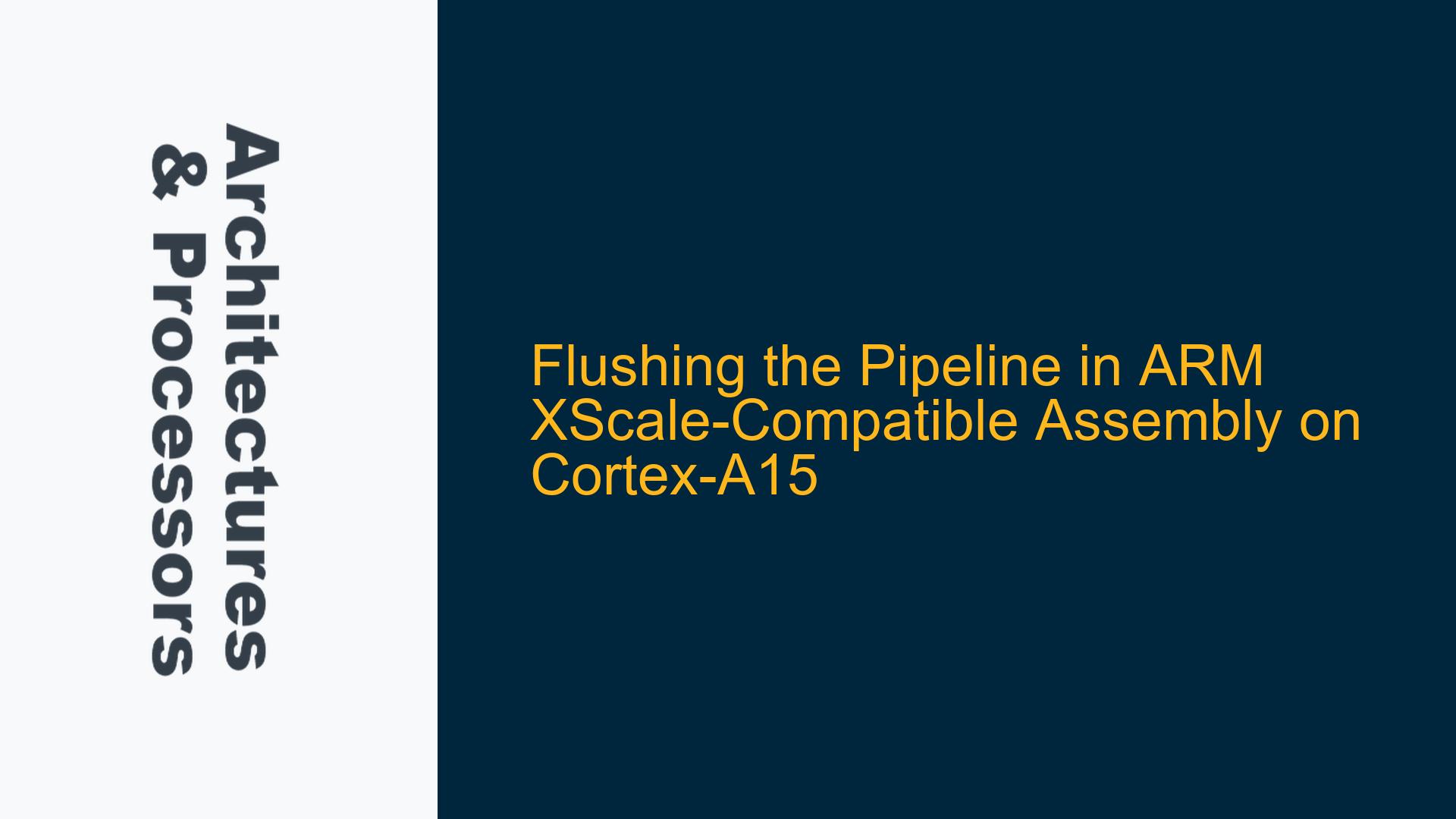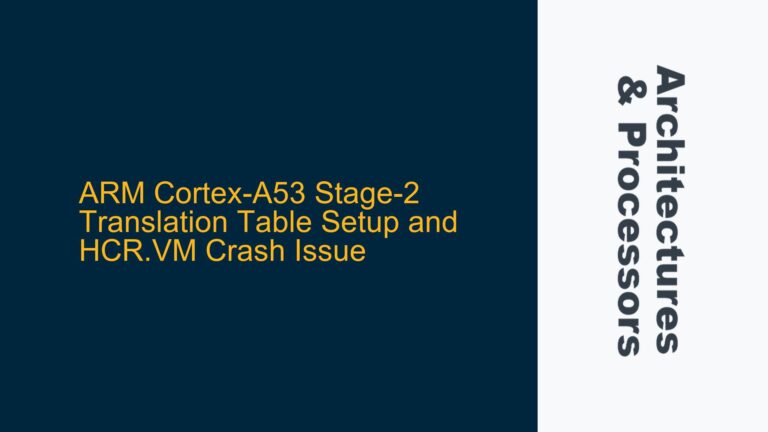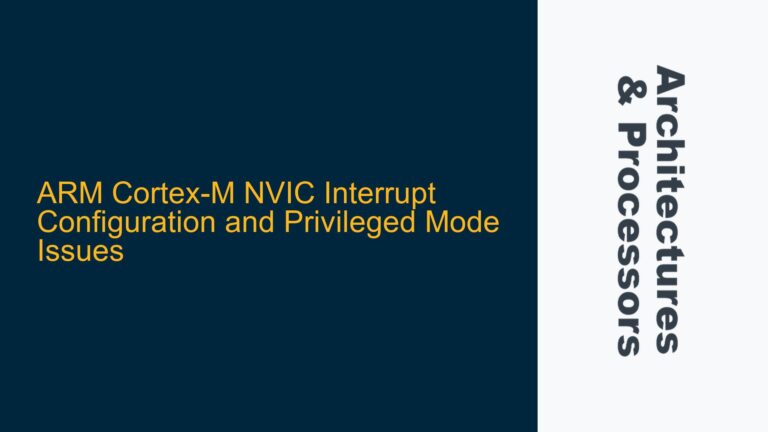ARM Cortex-A15 Pipeline Flushing Challenges with XScale Compatibility
The ARM Cortex-A15 processor, a high-performance core designed for advanced applications, incorporates a sophisticated pipeline architecture to enhance instruction throughput and execution efficiency. However, when attempting to maintain compatibility with legacy XScale architecture code, developers face significant challenges, particularly when it comes to pipeline management. The Cortex-A15 relies on modern ARMv7 instructions such as ISB (Instruction Synchronization Barrier) to ensure proper pipeline flushing, but these instructions are not available in the older XScale architecture. This discrepancy creates a critical issue for developers who must ensure that the pipeline is flushed correctly to maintain system stability and performance, especially during context switches, cache operations, or when modifying critical system registers.
The absence of the ISB instruction in XScale-compatible code means that developers must find alternative methods to achieve the same pipeline flushing effect. This is particularly important in scenarios where the processor must ensure that all previous instructions have completed execution before proceeding with subsequent operations. Failure to properly flush the pipeline can lead to unpredictable behavior, including incorrect execution of instructions, data corruption, and system crashes. The challenge is further compounded by the need to maintain compatibility with legacy code, which may not have been designed with the Cortex-A15’s pipeline architecture in mind.
Legacy XScale Architecture Limitations and Cortex-A15 Pipeline Requirements
The XScale architecture, based on the ARMv5TE instruction set, does not include the ISB instruction, which is a key component in modern ARM architectures for pipeline management. The ISB instruction ensures that all previous instructions are completed before any subsequent instructions are executed, effectively flushing the pipeline. In contrast, the XScale architecture relies on simpler mechanisms for pipeline control, which may not be sufficient for the more complex pipeline structure of the Cortex-A15.
The Cortex-A15’s pipeline consists of multiple stages, including fetch, decode, issue, and execute stages, each designed to maximize instruction throughput. However, this complexity also means that the pipeline can contain multiple instructions at various stages of execution at any given time. Without a proper mechanism to flush the pipeline, there is a risk that instructions may be executed out of order or that stale instructions may remain in the pipeline, leading to incorrect results or system instability.
One possible cause of pipeline-related issues in this context is the omission of necessary synchronization points in the code. In modern ARM architectures, the ISB instruction serves as a synchronization point, ensuring that all previous instructions have completed before proceeding. In XScale-compatible code, developers must find alternative ways to achieve this synchronization, such as using branch instructions or other architectural features that can force the pipeline to flush.
Another potential cause is the improper handling of cache operations. The Cortex-A15 includes a sophisticated cache hierarchy, and cache operations can have a significant impact on pipeline behavior. If cache operations are not properly synchronized with pipeline flushing, there is a risk that stale data may be used, or that cache inconsistencies may arise, leading to incorrect execution of instructions.
Implementing Pipeline Flushing with XScale-Compatible Assembly on Cortex-A15
To address the challenge of pipeline flushing in XScale-compatible code on the Cortex-A15, developers can employ several techniques to ensure proper synchronization and pipeline management. One approach is to use the BX (Branch and Exchange) instruction to force a pipeline flush. The BX instruction can be used to branch to the address of the next instruction, effectively flushing the pipeline by forcing the processor to refetch and re-execute the subsequent instructions. This technique mimics the effect of the ISB instruction by ensuring that all previous instructions have completed before proceeding.
To implement this approach, developers can use the following assembly code sequence:
BX lr
In this example, the BX lr instruction branches to the address contained in the link register (lr), which typically holds the return address for a function. By branching to this address, the processor is forced to flush the pipeline and refetch the next instruction, ensuring that all previous instructions have completed.
Another technique involves using the MOV instruction to manipulate the program counter (PC) directly. By moving the address of the next instruction into the PC, developers can force the processor to refetch and re-execute the subsequent instructions, effectively flushing the pipeline. This approach can be implemented as follows:
MOV pc, lr
In this example, the MOV pc, lr instruction moves the address contained in the link register (lr) into the program counter (pc), forcing the processor to branch to that address and flush the pipeline.
For more complex scenarios, developers may need to combine multiple techniques to achieve the desired pipeline flushing effect. For example, when performing cache operations or modifying critical system registers, it may be necessary to use a combination of branch instructions and cache management instructions to ensure proper synchronization and pipeline flushing.
In cases where the legacy code must remain compatible with both XScale and Cortex-A15 architectures, developers can use conditional assembly to include architecture-specific instructions. For example, the following code sequence uses conditional assembly to include the ISB instruction for Cortex-A15 and a branch instruction for XScale:
.ifdef CORTEX_A15
ISB
.else
BX lr
.endif
In this example, the .ifdef directive is used to conditionally include the ISB instruction for Cortex-A15 builds, while the BX lr instruction is included for XScale builds. This approach allows developers to maintain compatibility with both architectures while ensuring proper pipeline flushing.
In addition to these techniques, developers should also consider the impact of cache operations on pipeline behavior. The Cortex-A15 includes a sophisticated cache hierarchy, and cache operations can have a significant impact on pipeline behavior. To ensure proper synchronization, developers should use cache management instructions such as DMB (Data Memory Barrier) and DSB (Data Synchronization Barrier) in conjunction with pipeline flushing techniques. These instructions ensure that cache operations are properly synchronized with pipeline flushing, preventing issues such as stale data or cache inconsistencies.
For example, the following code sequence demonstrates the use of DMB and DSB instructions in conjunction with pipeline flushing:
DMB
DSB
BX lr
In this example, the DMB instruction ensures that all data memory operations are completed before proceeding, while the DSB instruction ensures that all data synchronization operations are completed. The BX lr instruction then flushes the pipeline, ensuring that all previous instructions have completed before proceeding.
In conclusion, while the absence of the ISB instruction in XScale-compatible code presents a challenge for pipeline flushing on the Cortex-A15, developers can employ a variety of techniques to achieve the desired effect. By using branch instructions, manipulating the program counter, and combining these techniques with cache management instructions, developers can ensure proper pipeline flushing and synchronization, maintaining system stability and performance while preserving compatibility with legacy code.






